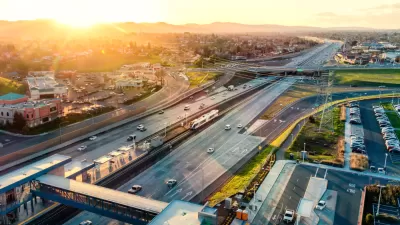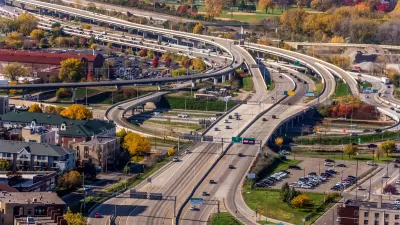The two states both approved measures that will set VMT reduction goals and create enforcement mechanisms to promote more climate-friendly policies.

Minnesota and California both recently made decisions that will help their states meet the goal of reducing vehicle miles traveled (VMT), reports Rayla Bellis in SSTI. Minnesota's Department of Transportation (MnDOT) "made a highly anticipated decision to adopt a number of recommendations from the state’s Sustainable Transportation Advisory Council (STAC) made in December 2020, including setting a preliminary statewide goal for a 20% VMT reduction statewide and per capita by 2050," with the final figure to be determined after a public input process. "MnDOT also plans to develop an approach for estimating program and project VMT outcomes by assessing both induced demand from adding lanes and reduced demand from increasing walking access, as well as evaluating the accuracy of travel demand forecasting methods."
On the West Coast, the California State Transportation Agency (CalSTA) released a draft of its Climate Action Plan for Transportation Infrastructure (CAPTI). The draft "comprises 28 action items, intended to 'help advance a slate of projects that meet climate goals, ensure that these projects are prioritized for state funding, and promote project construction and operations that minimize emission and impacts from climate change.'" In addition to meeting climate goals, CAPTI "also seeks to address the transportation system’s entrenched inequities, such as pollutants that disproportionately affect low-income and minority communities" through a stronger emphasis on equity and a new equity assessment tool.
FULL STORY: Minnesota and California move toward reducing VMT to address climate change

Maui's Vacation Rental Debate Turns Ugly
Verbal attacks, misinformation campaigns and fistfights plague a high-stakes debate to convert thousands of vacation rentals into long-term housing.

Planetizen Federal Action Tracker
A weekly monitor of how Trump’s orders and actions are impacting planners and planning in America.

In Urban Planning, AI Prompting Could be the New Design Thinking
Creativity has long been key to great urban design. What if we see AI as our new creative partner?

Portland Raises Parking Fees to Pay for Street Maintenance
The city is struggling to bridge a massive budget gap at the Bureau of Transportation, which largely depleted its reserves during the Civd-19 pandemic.

Spokane Mayor Introduces Housing Reforms Package
Mayor Lisa Brown’s proposals include deferring or waiving some development fees to encourage more affordable housing development.

Houston Mayor Kills Another Bike Lane
The mayor rejected a proposed bike lane in the Montrose district in keeping with his pledge to maintain car lanes.
Urban Design for Planners 1: Software Tools
This six-course series explores essential urban design concepts using open source software and equips planners with the tools they need to participate fully in the urban design process.
Planning for Universal Design
Learn the tools for implementing Universal Design in planning regulations.
Gallatin County Department of Planning & Community Development
Heyer Gruel & Associates PA
JM Goldson LLC
City of Camden Redevelopment Agency
City of Astoria
Transportation Research & Education Center (TREC) at Portland State University
Jefferson Parish Government
Camden Redevelopment Agency
City of Claremont





























